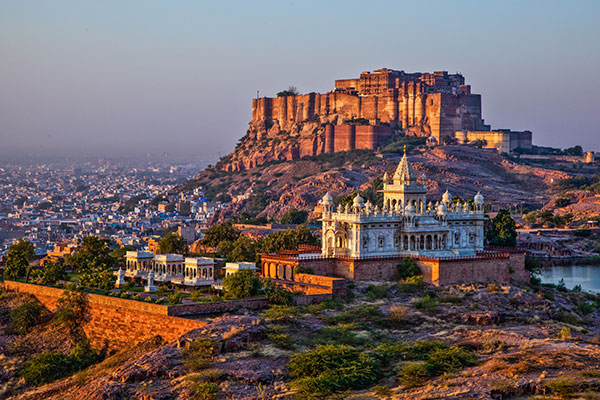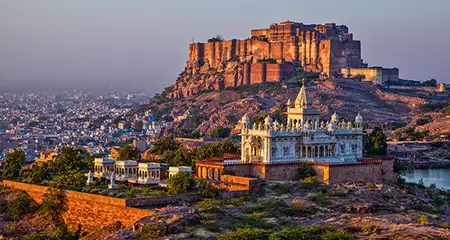Nestled atop a hill, at a height of 410 feet above the city of Jodhpur, Mehrangarh Fort stands as a majestic citadel of colossal proportions. Also known as Mehran Fort, it boasts of a history of more than 550 years and is surrounded by imposing walls. It is one of the largest forts in the country and is among the most formidable ones in Rajasthan. While the fort itself is an ode to Rajputana grandeur and architectural brilliance, the view it offers of the Jodhpur city spreading out below is no less impressive either. It’s not a surprise that the grand Mehran Fort is a prime attraction for travelers while planning a trip and booking rooms in the hotels in Jodhpur.
Want to know more about Mehrangarh, one of the top historical forts in Rajasthan? Here’s everything you need to know such as the history, architecture, things to see, museum, and other attractions at Mehrangarh Fort, Jodhpur.
Mehrangarh Fort, Jodhpur Information:
| Location | Sodagaran Mohalla, Jodhpur |
| Type | Fort |
| Also Known as | Mehran Fort |
| Timings | 9:00 am to 5:00 pm; every day |
| Entry Fee | Free |
| Museum Entry Fee |
₹ 100 for Indians; ₹ 50 for senior citizens, students, paramilitary personnel |
| Chokelao Bagh Entry | ₹ 30 per person |
| Still Camera | ₹ 100 |
| Video Camera | ₹ 200 |
| Elevator (one-way) | ₹ 50 |
| Tour Escort Fee | ₹ 120 |
| Audio Guide | ₹ 180 |
| Guide Fee | ₹ 300 to ₹ 600 (varies based on pax) |
| Commissioned by | Rao Jodha, the founder of Jodhpur |
| Year of Construction | 1459 |
| Architectural style | Various architectural styles from the 15th century to the 20th century |
| Present Custodian | Maharaja Gaj Singh II, the current head of the Rathode clan |
| Festivals | Rajasthan International Folk Festival in October, World Sufi Spirit Festival in February |
| Activities | Zip Lining by Jodhpur Flying Fox |
Note: Ticket sale closes at 5:00 pm. Entry is free for visitors on 12th May due to the occasion of Jodhpur Foundation Day. Only the audio guide, elevator fee, and manual charges are applicable.
Mehrangarh Fort: History
Mehrangarh Fort owes its origin to Rao Jodha, the ruler of Mandore and the founder of the city of Jodhpur. When Rao Jodha decided to shift his capital to a safer and elevated location in Jodhpur, he laid the foundation of this massive fort in 1459 on a hill named Bhakurcheeria aka the Mountain of Birds. The cornerstone of the fort was laid by Shri Karni Mata, a female warrior sage.
Legend has it that Rao Jodha had to relocate the sole occupant of the hill, a hermit named Cheeria Nathji, in order to build the fort. The enraged hermit cursed that the fort would suffer scarcity of water forever. To appease him, the king built a temple and a house for him within the fort premises. Some local stories even say that Rao Jodha buried alive a common man named Raja Ram Meghwal in the foundations of the fort to nullify the impact of the curse. Since the man had agreed to sacrifice his life willingly, the king promised to look after his family and continued to fulfill his promise diligently.
Over the years, Rao Jodha’s successors contributed much to the fort’s structure. They strengthened the fort’s walls and gates and also constructed new palaces and temples within the premises. It was in the 17th century, during the reign of Jaswant Singh of Marwar, that the fort was built into what we see today.
Mehrangarh Fort Architecture
Mehrangarh, one of the best places to visit in Jodhpur, is a celebration of various architectural styles. The fort and the structures within it were built over a long period of five centuries starting from the middle of the 15th century till the 20thcentury. So, its architecture reflects influences and elements from different eras, giving it a unique charm.
The fort is spread across an area of 5 km and is encircled by walls that are around 117 feet long and 70 feet wide. In some places, the walls of the fort rise up to a height of 120 feet, which adds to its formidable structure. There are seven beautiful gates adorning the fort walls, built at different points of time for different reasons. The fort complex also features a number of exquisitely decorated palaces and temples.
Mehrangarh Fort: Today
Today, a visit to Mehrangarh Fort counts among the most amazing things to do in Jodhpur. Apart from the spectacular palaces and expansive courtyards, the fort also houses a grand museum and an in-house museum shop. Folk dance and cultural performances take place almost every day within the fort.
Another key attraction at the fort is Chokelao Bagh, a beautifully restored 18th-century garden which is also the location of the open-air Chokelao Mahal Restaurant. You can relish a memorable candlelight dinner at the restaurant while enjoying the stunning views of the illuminated fort on one side and the city below on the other. If you are an adventure seeker, you can also try zip-lining at the fort.
Every year, the Rajasthan International Folk Festival is celebrated at the fort for five days in the month of October. The fort is also one of the venues for the World Sufi Spirit Festival held in February. Traditional festivals like Gangaur and Dussehra are also celebrated with much pomp and splendor at the fort. Currently, Maharaja Gaj Singh II, the present Rathode clan head, is the custodian of Mehrangarh.
The Rao Jodha Desert Rock Park, which is located adjacent to the fort, is another key attraction for travelers visiting Mehrangarh.
Mehrangarh Museum
The museum at the Mehrangarh Fort has different galleries showcasing an amazing collection of artifacts and decorative arts. The galleries at Mehrangarh Fort museum include:
- Elephant Howdah Gallery: Howdahs (seats used for riding the elephants) from the 18th and 19th centuries, including the silver howdah that Shah Jahan presented to Maharaja Jaswant Singh
- Daulat Khana Gallery: Some of the splendid treasures of this fort, including a few memorabilia of Emperor Akbar
- Turban Gallery: Various kinds of turbans used in Rajasthan by different communities and regions on various festivals and occasions
- Palanquin Gallery: A spectacular collection of palanquins including Pinjas (covered palanquins) and Rajat Khasa (lotus-shaped palanquin), to mention a few
- Painting Gallery: A fine collection Miniature Paintings and artwork belonging to the Marwar School
- Textile Gallery: Precious carpets, canopies, floor-spreads, tent walls, garments, and other furnishings from different centuries
- Sileh Khana or Arms Gallery: The swords of many kings and emperors, including Rao Jodha’s Khaanda that weighs over 7 pounds and the swords of Emperor Akbar and Timur
- Wood Craft Gallery: A number of artifacts carved out of wood and decorated with gold polish and ivory
- Cradle Gallery: A rare collection of cradles which include the electric cradle designed for the present king
Zip Lining at Mehrangarh
Jodhpur Flying Fox offers zip lining activities at the Mehrangarh Fort. It allows you to enjoy incredible views of the fort along with its step-well, battlements, lakes, the Rao Jodha eco-park, and the Jodhpur city as well.
- Timings:9:00 am to 5:00 pm
- Duration:45 to 90 minutes
- Cost:₹ 1400 onwards, depending on the session and the number of zips chosen
Things to See in the Mehrangarh Fort Complex
The majestic fort has a lot for visitors to explore. The top things to see at Mehrangarh Fort include:
- Sheesh Mahal or the Hall of Mirrors, Maharaja Ajit Singh’s bedroom that is intricately decorated with glass work.
- Phul Mahal or the Palace of Flowers, an ornate reception room built by Abhay Singh that dates back to the mid-18th Its architectural style matches those of Shah Jahan’s palaces.
- Moti Mahal or the Palace of Pearls, a beautiful chamber displaying the luster of the pearls. Here the queens would sit unseen and listen to the court proceedings.
- Takhat Vilas, a large interior room decorated with colored glass panes in the windows. It was the personal chamber of Takhat Singh.
- Jayapol built in 1806 by Maharaja Man Singh to celebrate his victories over the armies of Bikaner and Jaipur.
- Fattehpol built in 1707 by Maharaja Ajit Singh to commemorate his triumph over the Mughal forces. It has spikes to prevent any attack by elephants.
- Dedh Kamgra Pol where the impact of the cannonballs bombarded by the invading Jaipur army can be seen.
- Imritia Pol, another one of the fort gates
- Suraj Pol, the gate that leads to the museum
- Loha Pol, the final gate that leads to the main section of the fort
- Kirat Singh Soda’s chhatri, an elaborate structure that marks the spot where a soldier had fell down in 1808 while defending the fort
- Chamunda Mata Temple built by Rao Jodha in 1460
Lesser-known Facts about Mehrangarh Fort, Jodhpur
- The name Mehrangarh means ‘the Citadel of the Sun’, which refers to the mythical claim that the Rathodes are the descendants of the Sun god.
- A wall of the fort bears handprints which are believed to be of the royal women who performed Sati or self-immolation on their husband’s pyre.
- The fort was the location for many Hollywood and Bollywood films, including The Dark Knight Rises (2012), The Jungle Book (1994), and Awarapan (2007).
- In 2015, Radiohead guitarist and composer Jonny Greenwood, producer of Radiohead Nigel Godrich, and composer Shye Ben Tzur recorded a joint musical album at the fort.
- A large number of eagles gather at the fort every day in the afternoon from around 3:30 pm to 4:00 pm. The fort management has a person engaged to feed the eagles from atop a tower overlooking the Chokelao Gardens.
- Rudyard Kipling described the fort as the work of angels, giants, and fairies.
Attractions near Mehrangarh Fort, Jodhpur
- Jaswant Thada (800 m)
- Rao Jodha Desert Rock Park (850 m)
- Toorji Ka Jhalra (2.8 km)
- Mahamandir Temple, Jodhpur (3.1 km)
- Jodhpur Government Museum (3.5 km)
- Bishnoi Village (4.6 km)
- Umaid Bhawan Palace (6.8 km)
- Machiya Safari Park (7 km)
- Balsamand Lake (7.2 km)
- Kailana Lake (7.5 km)
- Mandore Gardens (8.2 km)
- Masuriya Hills Garden (9.7 km)
So, now that you know all about Mehrangarh, Jodhpur why not plan a trip to this impressive fort? Whether you are a history buff, casual backpacker, art connoisseur or adventure seeker, we are sure you won’t have a dull moment here.




























